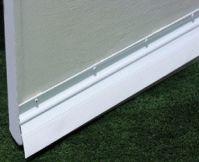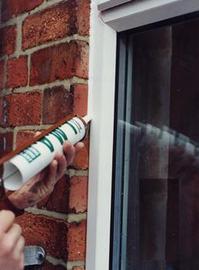Losing your cool this summer? How to keep the cold air in, create an efficient home
Dear Keith—During these extremely hot summer days I know my air conditioner is working extra hard. How can I help keep the cool air in to make my home more efficient?
—Anne from Plymouth
Hi, Anne,
According to Consumers Energy, one of the least expensive ways to decrease the usage of your air conditioner is to replace the filter and make sure the condenser is clean and free of debris. The condenser is the unit that is located on the exterior of the home usually on the side or in the rear of the home. You can easily clean the condenser by rinsing it off using a garden hose. Another way is to weatherproof your windows and doors. Weatherproofing is popular during the winter months but is equally important and cost-effective during the summer months while running your air conditioner. There are many options to help seal your windows and doors to help keep the cool air in during the summer and the frigid cold out during the winter.
Doors must be sealed tightly in order to keep hot drafts from coming in or letting cool air out. There are many different materials you can use on the sides, top, and bottom of your exterior doors to be sure they are sealed properly. Below are some inexpensive options to help seal your door.
1. Self-stick foam weatherstripping: Easy to install and a very inexpensive solution. The most important tip is to make sure the surface is very clean before applying the sticky adhesive. Apply the self-stick foam weatherstripping to the inside face of the door jamb. Though this option is inexpensive, the durability is low, especially during extreme weather conditions.
2. Bronze weatherstripping: Thin bronze strips can be installed inside the door jamb. The strips are attached with small nails and the outside half of the strip must be bent to create an edge. When the door is closed it comes in contact with the bent edge, bending it back slightly, which creates a tight fit between the strip and door. This option can be tricky and time consuming, but it lasts for years.

Figure 1 Door Sweep by www.energyfederation.org
3. Vinyl bulb threshold: This threshold is a combination of vinyl and weatherstrip that is available in many sizes. A vinyl bulb is more durable than a traditional threshold and helps keep out not only the hot air, but dirt and dust from the outside. A disadvantage is they can wear relatively easily from foot traffic.
4. Door sweep: Installed on the bottom of a door and available in a variety of materials such as aluminum, vinyl, or plastic. Door sweeps are relatively easy to install and can be adjusted to uneven thresholds. Door sweeps do wear down over time, but you can choose one that has slot holes to adjust the height as it wears.
Windows can let in hot air in different ways. Convection is the loss caused by moving air such as drafts. Conduction lets the heat in by heating up the window from the outside and transferring the heat inside. Heat gain is also caused by radiance simply transitioning through the transparent barrier.

Figure 2 Window Caulk by www.northsd.com
When sealing windows, the first thing to do is check for drafts or convection air loss. Feel around all seams of the windows for hot drafts; I have successfully used the candle and flame trick. Exterior caulk can dry and crack in hot weather and will need to be replaced as it wears. A razor blade or caulk remover can be used to remove the caulk. All of the old caulk must be removed so the new caulk adheres properly. At HandyPro, we have been successful using Vulkem and Quad exterior caulk. Caulk will create an air-tight barrier and keep hot air from seeping in all season long.
Another alternative for windows is to hang insulated window blinds. They have compressible insulation in them and the blinds can be lowered during times of direct sunlight and just the opposite during winter months. There are also many energy-saving window treatments available. Both will lower the conduction heat gain by adding an additional layer between the hot outdoors and your cool home as well as lower the radiance that enters the home. Also, you can close off rooms that are not being used during the day (such as closets) and adjust vents in the areas not occupied.
Combining many of these options will allow you to keep the cool in and create an overall more efficient home. Other options include uninterrupted electrical services; call your electrical company for details. Both DTE and Consumers Energy advise to keep your thermostat temperature at about 78 degrees.
Ceiling and whole house fans can be used to help circulate air to keep the cool air moving throughout your home. Get your air conditioner cleaned and inspected by a professional yearly. These inexpensive options are easy to implement and will last at least the whole hot summer and will continue to create a more weatherproof home.
Paul is a State of Michigan Licensed Builder. Paul serves as president and founding member of Nationally franchised HandyPro Handyman Service, servicing Washtenaw, Wayne, and Oakland Counties. Listen to Paul every Saturday at 11 a.m. on “It’s Your Home, Let’s Talk About It” WAAM Talk 1600AM. E-mail questions or comments to kpaul@handypro.com


Comments
BobbyJohn
Mon, Jul 19, 2010 : 10:16 p.m.
Anne I wouldn't worry about your Air conditioner working "hard". Actually, a properly sized (and keep in mind that most central air conditioning systems are WAY oversized) air conditioning system should be running continuously during the middle of the day. That way it will do a good job of attacking the real culprit of discomfort during the summertime, humidity.If you don't feel comfortable at 75-77 degrees in your house on a hot day w/ the A/C on, that is an indicator your A/C is oversized and thus inefficient and uncomfortable for you and your pocketbook. Bobby Frank RJ Frank Home Inspections/ A Buyers Ally